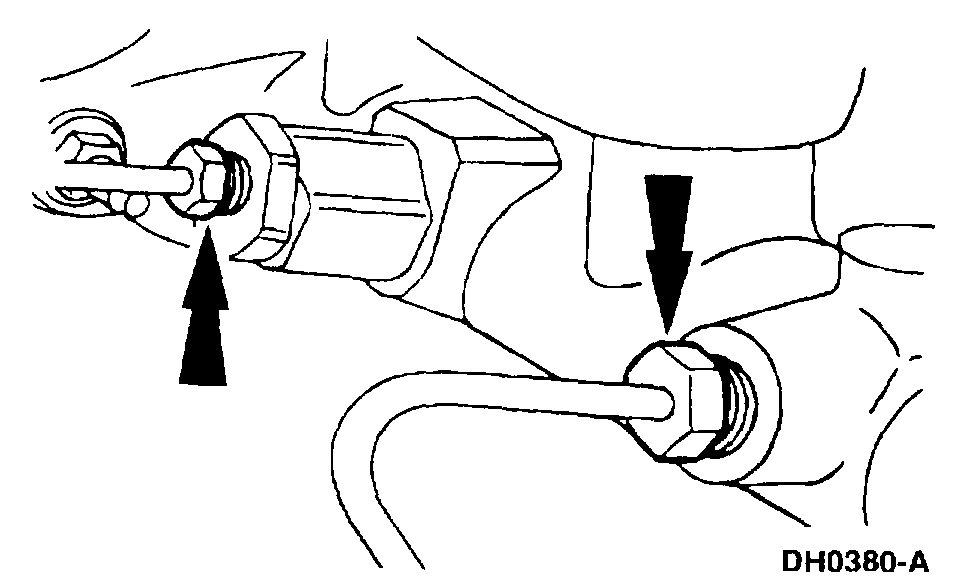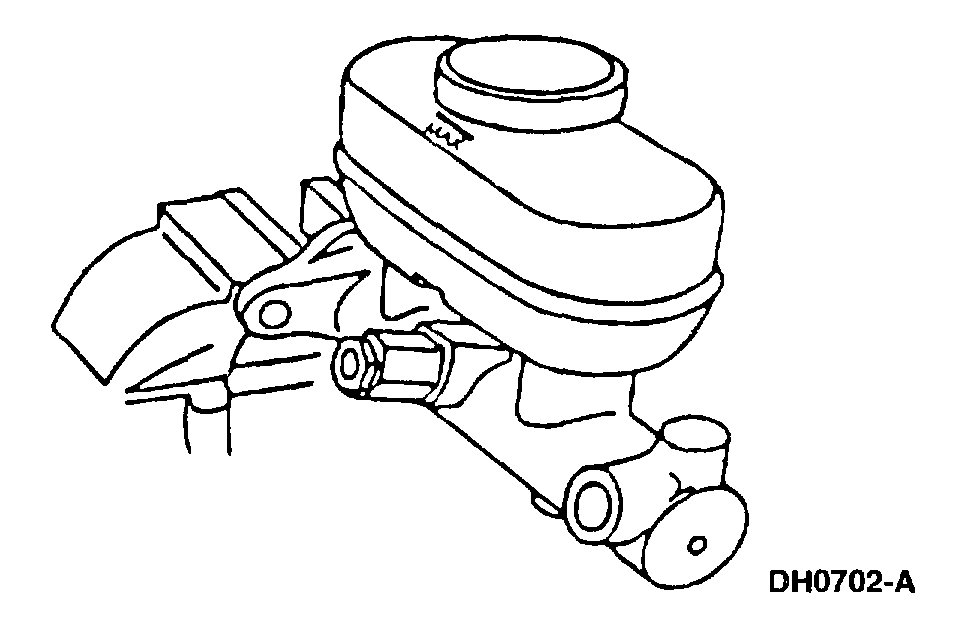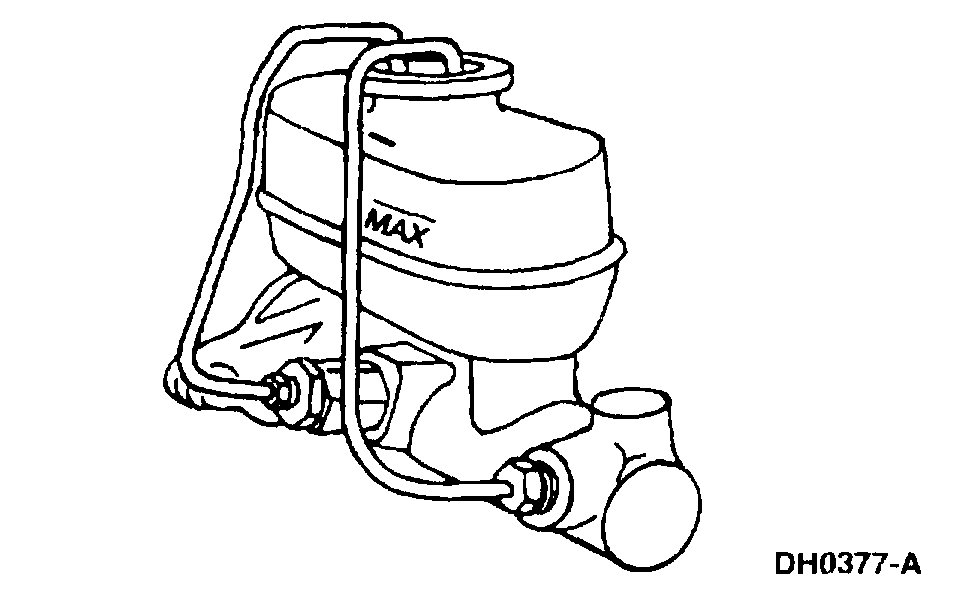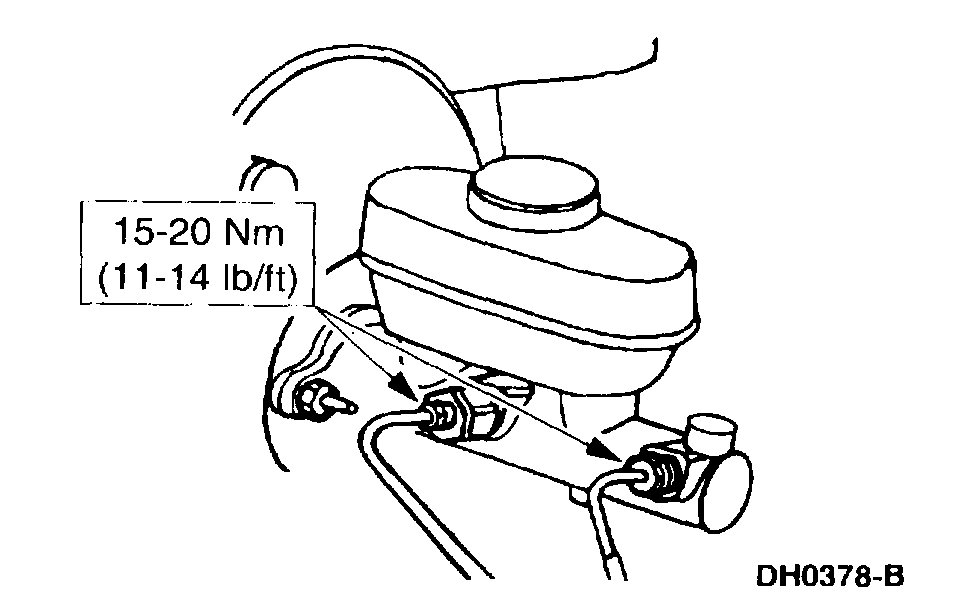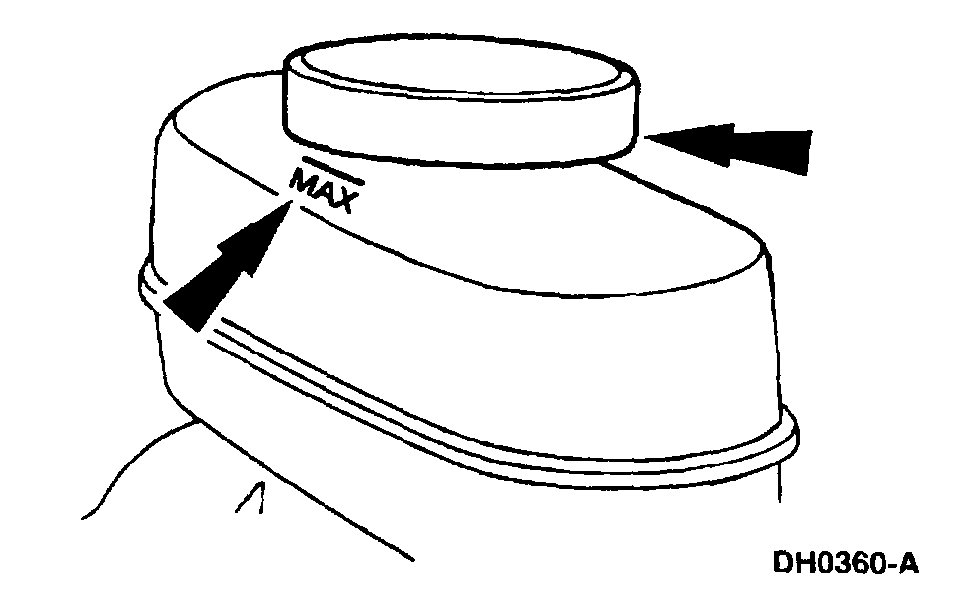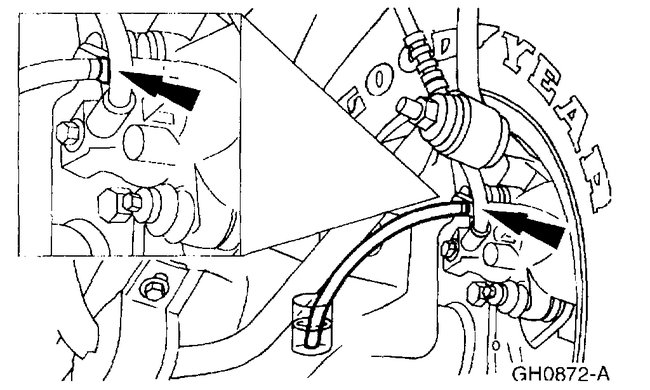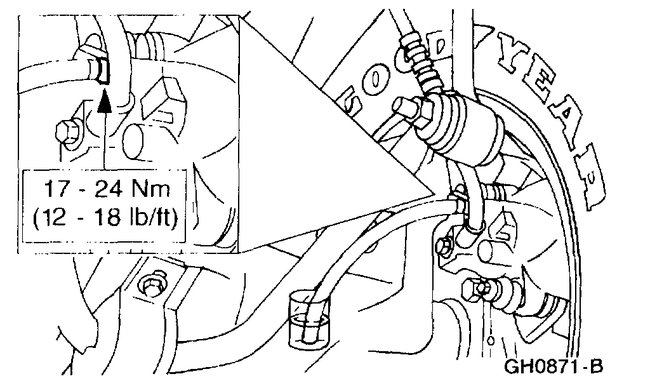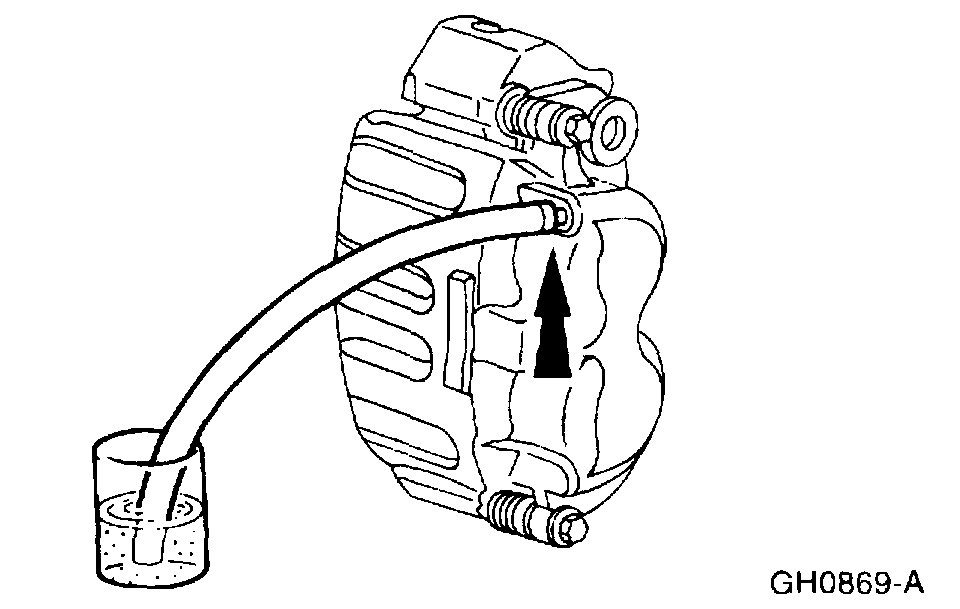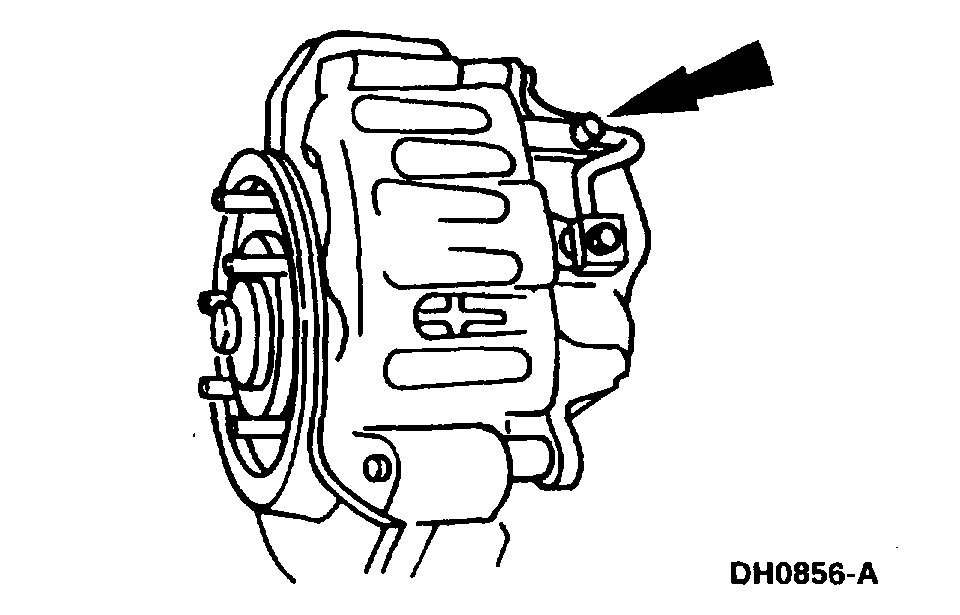Hi,
Normally, the first thing I would tell you is the master cylinder or there is a leak. Take a look through this link:
https://www.2carpros.com/articles/brake-pedal-goes-to-the-floor
So, if everything is new, there are no leaks, and you bled the system, there must still be air in it.
Take a look through these directions for bench bleeding the MC and let me know if this is what was done. The attached pics correlate with the directions.
____________________
1998 Ford Truck F 150 4WD Pickup V8-5.4L SOHC VIN L
Master Cylinder Bleeding
Vehicle Brakes and Traction Control Hydraulic System Brake Bleeding Service and Repair Procedures Master Cylinder Bleeding
MASTER CYLINDER BLEEDING
WARNING: BRAKE FLUID CONTAINS POLYGLYCOL ETHERS AND POLYGLYCOLS. AVOID CONTACT WITH EYES. WASH HANDS THOROUGHLY AFTER HANDLING. IF BRAKE FLUID CONTACTS EYES, FLUSH EYES WITH RUNNING WATER FOR 15 MINUTES. GET MEDICAL ATTENTION IF IRRITATION PERSISTS. IF TAKEN INTERNALLY, DRINK WATER AND INDUCE VOMITING. GET MEDICAL ATTENTION IMMEDIATELY.
CAUTION:
- Do not allow the brake master cylinder reservoir to run dry during the bleeding operation. Keep the brake master cylinder reservoir filled the specified brake fluid. Never reuse the brake fluid that has been drained from the hydraulic system.
- Brake fluid is harmful to painted and plastic surfaces. If brake fluid is spilled onto a painted or plastic surface, immediately wash it with water.
NOTE:
- When any part of the hydraulic system has been disconnected for repair or replacement, air can enter the system and cause spongy brake pedal action. This requires bleeding of the hydraulic system after it has been properly connected. The hydraulic system can be bled manually or with pressure bleeding equipment
- When the brake master cylinder has been replaced or the system has been emptied, or partially emptied, it should be primed to prevent air from entering the system.
pic 1
1. For in-vehicle priming, disconnect the brake lines.
pic 2
2. For bench priming, mount the brake master cylinder in a vise.
pic 3
3. Install short brake tubes with the ends submerged in the brake master cylinder reservoir, and fill the brake master cylinder reservoir with High Performance DOT 3 Brake Fluid C6AZ- 19542-AB or equivalent DOT 3 fluid meeting Ford specification ESA-M6C25-A.
4. Have an assistant pump the brake pedal, or slowly depress the primary piston until clear fluid flows from both brake tubes, without air bubbles.
5. If the brake master cylinder is being primed at the bench, install it in the vehicle.
pic 4
6. Remove the short brake tubes, and install the brake outlet tubes.
7. Bleed each brake tube at the brake master cylinder as follows:
1 Have an assistant pump the brake pedal, and then hold firm pressure on the brake pedal.
2 Loosen the rearmost brake tube fittings until a stream of brake fluid comes out. While the assistant maintains pressure on the brake pedal, tighten the brake tube fitting.
3 Repeat this operation until clear, bubble-free fluid comes out.
4 Refill the brake master cylinder reservoir as necessary. Repeat the bleeding operation at the front brake tube.
_____________________________
Here are the procedures for bleeding. Take a look through them as well.
1998 Ford Truck F 150 4WD Pickup V8-5.4L SOHC VIN L
Manual Bleeding
Vehicle Brakes and Traction Control Hydraulic System Brake Bleeding Service and Repair Procedures Manual Bleeding
MANUAL BLEEDING
WARNING: BRAKE FLUID CONTAINS POLYGLYCOL ETHERS AND POLYGLYCOLS. AVOID CONTACT WITH EYES. WASH HANDS THOROUGHLY AFTER HANDLING. IF BRAKE FLUID CONTACTS EYES, FLUSH EYES WITH RUNNING WATER FOR 15 MINUTES. GET MEDICAL ATTENTION IF IRRITATION PERSISTS. IF TAKEN INTERNALLY, DRINK WATER AND INDUCE VOMITING. GET MEDICAL ATTENTION IMMEDIATELY.
CAUTION:
- Do not allow the brake master cylinder reservoir to run dry during the bleeding operation. Keep the brake master cylinder reservoir filled with the specified brake fluid. Never reuse the brake fluid that has been drained from the hydraulic system.
- Brake fluid is harmful to painted and plastic surfaces. If brake fluid is spilled onto a painted or plastic surface, immediately wash it with water.
NOTE: When any part of the hydraulic system has been disconnected for repair or replacement, air may get into the system and cause spongy brake pedal action. This requires bleeding of the hydraulic system after it has been properly connected. The hydraulic system can be bled manually or with pressure bleeding equipment.
imageOpen In New TabZoom/Print
1. Clean all dirt from and remove the brake master cylinder filler cap and fill the brake master cylinder reservoir with the specified brake fluid
imageOpen In New TabZoom/Print
2. Place a box end wrench on the RH rear bleeder screw. Attach a rubber drain tube to the RH rear bleeder screw and submerge the free end of the tube in a container partially filled with clean brake fluid.
3. Have an assistant pump the brake pedal and then hold firm pressure on the brake pedal.
4. Loosen the RH rear bleeder screw until a stream of brake fluid comes out. While the assistant maintains pressure on the brake pedal, tighten the RH rear bleeder screw.
- Repeat until clear, bubble-free fluid comes out.
- Refill the brake master cylinder reservoir as necessary.
imageOpen In New TabZoom/Print
5. Tighten the RH rear bleeder screw.
6. Repeat Steps 2, 3, 4, and 5 for the LH rear bleeder screw.
imageOpen In New TabZoom/Print
7. Place a box end wrench on the RH front disc brake caliper bleeder screw. Attach a rubber drain tube to the RH front disc brake caliper bleeder screw, and submerge the free end of the tube in a container partially filled with clean brake fluid.
8. Have an assistant pump the brake pedal and then hold firm pressure on the brake pedal.
9. Loosen the RH front disc brake caliper bleeder screw until a stream of brake fluid comes out. While the assistant maintains pressure on the brake pedal, tighten the RH front disc brake caliper bleeder screw.
- Repeat until clear, bubble-free fluid comes out.
- Refill the brake master cylinder reservoir as necessary.
imageOpen In New TabZoom/Print
10. Tighten the RH front disc brake caliper bleeder screw.
11. Repeat Steps 7, 8, 9, and 10 for the LH front disc brake caliper bleeder screw.
__________________________-
1998 Ford Truck F 150 4WD Pickup V8-5.4L SOHC VIN L
Manual Bleeding
Vehicle Brakes and Traction Control Hydraulic System Brake Bleeding Service and Repair Procedures Manual Bleeding
MANUAL BLEEDING
WARNING: BRAKE FLUID CONTAINS POLYGLYCOL ETHERS AND POLYGLYCOLS. AVOID CONTACT WITH EYES. WASH HANDS THOROUGHLY AFTER HANDLING. IF BRAKE FLUID CONTACTS EYES, FLUSH EYES WITH RUNNING WATER FOR 15 MINUTES. GET MEDICAL ATTENTION IF IRRITATION PERSISTS. IF TAKEN INTERNALLY, DRINK WATER AND INDUCE VOMITING. GET MEDICAL ATTENTION IMMEDIATELY.
CAUTION:
- Do not allow the brake master cylinder reservoir to run dry during the bleeding operation. Keep the brake master cylinder reservoir filled with the specified brake fluid. Never reuse the brake fluid that has been drained from the hydraulic system.
- Brake fluid is harmful to painted and plastic surfaces. If brake fluid is spilled onto a painted or plastic surface, immediately wash it with water.
NOTE: When any part of the hydraulic system has been disconnected for repair or replacement, air may get into the system and cause spongy brake pedal action. This requires bleeding of the hydraulic system after it has been properly connected. The hydraulic system can be bled manually or with pressure bleeding equipment.
pic 5
1. Clean all dirt from and remove the brake master cylinder filler cap and fill the brake master cylinder reservoir with the specified brake fluid
pic 6
2. Place a box end wrench on the RH rear bleeder screw. Attach a rubber drain tube to the RH rear bleeder screw and submerge the free end of the tube in a container partially filled with clean brake fluid.
3. Have an assistant pump the brake pedal and then hold firm pressure on the brake pedal.
4. Loosen the RH rear bleeder screw until a stream of brake fluid comes out. While the assistant maintains pressure on the brake pedal, tighten the RH rear bleeder screw.
- Repeat until clear, bubble-free fluid comes out.
- Refill the brake master cylinder reservoir as necessary.
pic 7
5. Tighten the RH rear bleeder screw.
6. Repeat Steps 2, 3, 4, and 5 for the LH rear bleeder screw.
pic 8
7. Place a box end wrench on the RH front disc brake caliper bleeder screw. Attach a rubber drain tube to the RH front disc brake caliper bleeder screw, and submerge the free end of the tube in a container partially filled with clean brake fluid.
8. Have an assistant pump the brake pedal and then hold firm pressure on the brake pedal.
9. Loosen the RH front disc brake caliper bleeder screw until a stream of brake fluid comes out. While the assistant maintains pressure on the brake pedal, tighten the RH front disc brake caliper bleeder screw.
- Repeat until clear, bubble-free fluid comes out.
- Refill the brake master cylinder reservoir as necessary.
pic 9
10. Tighten the RH front disc brake caliper bleeder screw.
11. Repeat Steps 7, 8, 9, and 10 for the LH front disc brake caliper bleeder screw.
______________________________
If the front brake calipers were replaced, confirm the bleeder is at the top of the caliper. If the calipers are mixed up, the bleeder will be on the bottom making it impossible to get the air out of the system.
Let me know.
Joe
Images (Click to make bigger)
SPONSORED LINKS
Wednesday, March 10th, 2021 AT 11:17 AM
